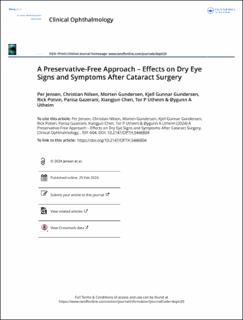A Preservative-Free Approach – Effects on Dry Eye Signs and Symptoms After Cataract Surgery
Jensen, Per Graae; Nilsen, Christian; Gundersen, Morten; Gundersen, Kjell Gunnar; Potvin, Rick; Gazerani, Parisa; Chen, Xiangjun; Utheim, Tor Paaske; Utheim, Øygunn Aass
Peer reviewed, Journal article
Published version
Permanent lenke
https://hdl.handle.net/11250/3120229Utgivelsesdato
2024Metadata
Vis full innførselSamlinger
Sammendrag
Purpose: To compare the effect of treatment with preservative-free dexamethasone, NSAIDs and trehalose/hyaluronic acid eye drops
with the preservative benzalkonium chloride containing dexamethasone and NSAIDs after cataract surgery in dry versus non-dry eyes.
Patients and Methods: In this prospective randomized intervention study, dry eye tests were performed before and 6 weeks after
cataract surgery. Patients were considered as having dry eye, SDE (sign of dry eye), if at least one of the following dry eye tests were
abnormal; corneal fluorescein staining (CFS), non-invasive keratograph breakup time (NIKBUT) or tear osmolarity. Patients with SDE
were randomly assigned to one of two groups. Group 1 patients were treated with dexamethasone and bromfenac eye drops with the
preservative benzalkonium chloride (BAC). Group 2 patients were treated with preservative-free dexamethasone and preservative-free
diclofenac, as well as a preservative-free lubricant with trehalose and hyaluronic acid both before and after surgery. Patients with
normal tear film status acted as the control group (group 3) and received same treatment as group 1.
Results: A total of 215 patients were enrolled six weeks after surgery, the number of patients with SDE decreased significantly in
groups 1 and 2 (p <0.001). Subjective symptoms and objective measures including osmolarity, NIKBUT, CFS, and tear film thickness
(TFT) improved after surgery, tear production remained unchanged, while corneal sensitivity and meibomian gland dysfunction
(MGD) parameters worsened. In the control group with normal tear-film status, SDE increased significantly after the surgery (p
<0.001). There were no statistically significant differences in tear film parameters between the three groups after surgery.
Conclusion: After cataract surgery, patients with mild to moderate dry eyes may experience improved tear film status and reduced
symptoms. However, we found no additional beneficial effect on dry eye parameters with treatment with preservative-free dexamethasone,
NSAIDs, and lubricants compared to preservative-containing eye drops.

